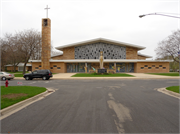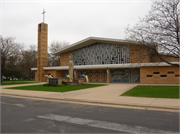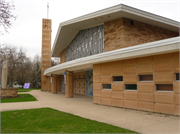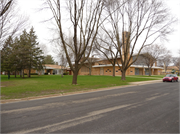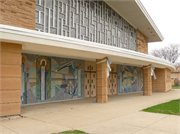Property Record
5101 SCHOFIELD ST
Architecture and History Inventory
| Historic Name: | IMMACULATE HEART OF MARY CHURCH |
|---|---|
| Other Name: | IMMACULATE HEART OF MARY CHURCH (CATHOLIC) |
| Contributing: | |
| Reference Number: | 5594 |
| Location (Address): | 5101 SCHOFIELD ST |
|---|---|
| County: | Dane |
| City: | Monona |
| Township/Village: | |
| Unincorporated Community: | |
| Town: | |
| Range: | |
| Direction: | |
| Section: | |
| Quarter Section: | |
| Quarter/Quarter Section: |
| Year Built: | 1961 |
|---|---|
| Additions: | |
| Survey Date: | 19792018 |
| Historic Use: | house of worship |
| Architectural Style: | Contemporary |
| Structural System: | |
| Wall Material: | Concrete Block |
| Architect: | Siberz, Purcell, and Cuthbert |
| Other Buildings On Site: | |
| Demolished?: | No |
| Demolished Date: |
| National/State Register Listing Name: | Not listed |
|---|---|
| National Register Listing Date: | |
| State Register Listing Date: |
| Additional Information: | The congregation was founded in 1950. "Immaculate Heart of Mary, which, with its church, parish hall, school, playground and rectory, sprawls over several acres occupying two full blocks on Schofield Street, began with not much more than will power. In February of 1950, William P. O’Connor, the Bishop of Madison, announced the formation of Immaculate Heart of Mary Parish for all Catholics within the 25-square-mile area bounded by County BB (old Highway 30, not Cottage Grove Road] on the north, the Cottage Grove-Blooming Grove township line on the east, the Milwaukee Road tracks on the west and south to and including McFarland and the eastern shore of Lake Waubesa. A census of the new parish revealed that there were more than 200 Catholic families living in the area formerly belongs to St. Bernard’s Parish on Madison’s east side. Father Jerome Mersberger, assistant for the previous six years at St. Bernard's Church on Atwood Avenue, was named pastor and directed the organization of the new congregation. A site of the new church was purchased the previous year by the Catholic Diocese of Madison. It was formerly part of the Elelstad and Seelinger farms west of Mona Drive and just east of the homes fringing Shore Acres plat. The new parish had a pastor and some land to meet and worship immediately. For less than $3000, the able members of the newly formed parish cleaned, repaired, painted, decorated and furnished an old, unused chicken coop on the Joe Fix farm at 706 West Dean Avenue for use as a temporary church. The Fix Family had recently sold the property to Roy Cannon, developer. Mr. Gannon, a member of the parish, arranged for the use of the building. Courage, ambition and imagination were needed to make the dilapidated old poultry house useable as a temporary church. Bound together by a strong desire to have a church here in their community, parishioners worked many hours cleaning and repairing the 21' x 49' wooden structure, which they painted yellow. Several Knights of Columbus and the painters of the parish united in painting the rafters and ceiling white, the walls a pale green, and the floor maroon. They mounted a gold cross, replaced windows, built steps and an entranceway, and made a second (emergency) exit, as required by law for public buildings. In addition, they removed the old wiring and installed a ventilating system and minimal lighting. Material costs were kept to the minimum by the generosity of several local businesses. Carpenters, upholsterers, seamstresses and general workers who were members of the parish created the sanctuary that boasted an eight-foot liturgical altar fashioned out of redwood standing on a green-carpeted platform, and backed by drapes of green and gold. To the right of the front entrance was a one-manual electric organ, rented at a cost of $6.50 per month. Special folding chairs, each equipped with a kneeler, accomodated 145 people. There was no plumbing, and very little heat for the winter months. Bales of marsh hay were banked around the outside of the building to help block out the drafts, but it often was so cold that 'church clothes' meant the warmest winter garb a parishioner might own, rather than the usual Sunday finery. After five weeks of preparation, the little church welcomed its parish. One hundred and twelve persons were present on June 16, 1950, to witness Father Mersberger bless the little church and celebrate the Mass. In the afternoon of opening day an Open House allowed 847 people to isnpoect the church. Six hundred and fifty-three persons toured the rectory furnished largely by friends of the new parish. Masses were scheduled for 7:00 am, 9:00 am and 11:00 am on the following Sundays. On Thanksgiving Day (1950), 27 Monona area families attended the first mass of Thanksgiving for their newly-formed parish in the renovated chicken coop. On that cold Thanksgiving morning of 1950, the little chicken coop church was filled to capacity (140) with parish families and their holiday guests. One of the charter members who attended the mass recalls how Father Mersberger was recounting the blessings of working together to form the new parish, when she noticed a number of uplifted faces in the pew ahead of her. By September 15, 1950, the parishioners began construction of a more permanent building on the church property on Schofield Street and the next year they saw it completed. The new building included a temporary rectory, auditorium and gym, and a small, but beautiful chapel in the area later used as the nursery. Sunday Masses and other liturgical events took place in the gym. Built and furnished at an approximate cost of $175,000, the rambling ranch-type brick structure was large enough to accommodate 650 people for church services or 400 people for dinners in the parish hall or gymnasium which included a modern kitchen. The 50' x 104' hall was also used for stag and theater productions and a variety of other activities. Three hundred people attended the dedication, officiated by the Most Reverend William P. O'Connor, Bishop of Madison. In 1954, the parish built a $85,000 Catholic elementary school of seven classrooms adjoining the parish hall at the north east end. The firm of Gausewitz and Cashin designed the school building, which occupied 8,200 square feet of space. Plans called for a capacity of 40 people to each classroom. The east and west sides of the one-story, buff brick, flat roofed building were almost entirely of duo-pane window with a four foot overhang to cut glare. The Sisters of St. Francis from St. Joseph's convent in Milwaukee, who accepted the teaching duties of the new school, lived in a house across the Schofield Street from the school until a convent was completed in 1968. A few years later, the parishioners added a wing that included rooms for the upper grades, music room, religious education, office, kitchen and Marian Hall. Finally after years of preparation and fund-raising, the hard-working members could watch their house of worship take shape. On December 10, 1959, IHM school children, members of the parish building committee, several mothers, and Father Leo Joyce, associate pastor, joined Father Mersberger as he broke ground for the new church and offered a prayer for the safety of those involved in the construction. almost two years later, the magnificent edifice was dedicated on Mothers' Day. May 14, 1961, with Bishop O'Connor officiating. The church, which provides seating for 1,2000, was designed by Siberz, Purcell, and Cuthbert, Madison architects. The exterior upper portions, sides and rear are split-face Kakato stone, and the lower portion and bell tower are sand-rubbed finish, reverse-sawed pink Kasato veined stone. The main entrance is faced with two 25-foot wide and 11-foot high mosaic murals, composed of pieces of colored Italian glass resembling stone (called tessara) patterned in West Berlin, Germany. The facde window is 56 feet wide and 20 feet high at its center, and is made of leaded antique glass in various tones, highlighted by pieces of brilliant, faceted jewel glass. The bell tower is 57 feet high, surmounted by a 16-foot anodized aluminum cross, weighing 880, 440, and 265 pounds, that were cast in Holland. The stations of the cross are depicted in the fourteen windows lining the inner side walls of the church. At night, each window is illuminated by more than 55 feet of fluorescent lightning." - Richard Bernstein, 2016 2018 - The Immaculate Heart of Mary Church was completed in 1961 and displays elements of mid-century Contemporary-style ecclesiastical architecture. The church rests on a concrete foundation and has an irregular polygonal plan and irregular roof configuration that consists of a main front gable and flat-roof portions across the front and rear elevations; a shed-roof portion with rounded eaves protrudes through the front-gable portion near the rear of the building. All eaves have wide overhangs. Most exterior wall surfaces are clad in stone and the main entrance is faced with two, glass, mosaic murals. Fenestration consists of multi-light leaded glass windows. The expansive window on the main facade features glass in various tones and is accented with pieces of faceted jewel glass and narrow, vertical-oriented, multi-light windows are located on the side elevations. Horizontally divided multi-light windows are visible on the rear elevation. A stone-clad bell tower extends through the flat-roof canopy across the main facade near the southeast corner of the church building. The bell tower is capped with an anodized aluminum cross. The church was designed by Madison-area architectural firm Siberz, Purcell, and Cuthbert and is a distinctive example of mid-twentieth-century Contemporary-style architecture. |
|---|---|
| Bibliographic References: | Immaculate Heart of Mary Catholic Church, “Our History,” Immaculate Heart of Mary Catholic Church and School, 2019, https://www.ihmcatholicparish.org/our-history/. Monona Landmarks Commission. City of Monona: Its Heritage and Landmarks. 2nd ed. Monona Wis.: Monona Landmarks Commission, 2011. 127-129. |
| Wisconsin Architecture and History Inventory, State Historic Preservation Office, Wisconsin Historical Society, Madison, Wisconsin |

